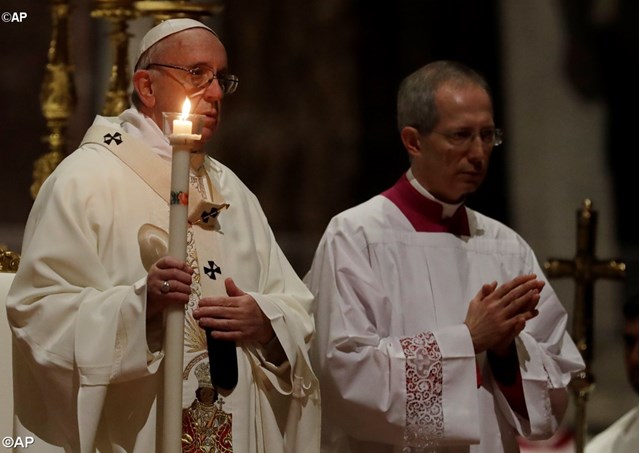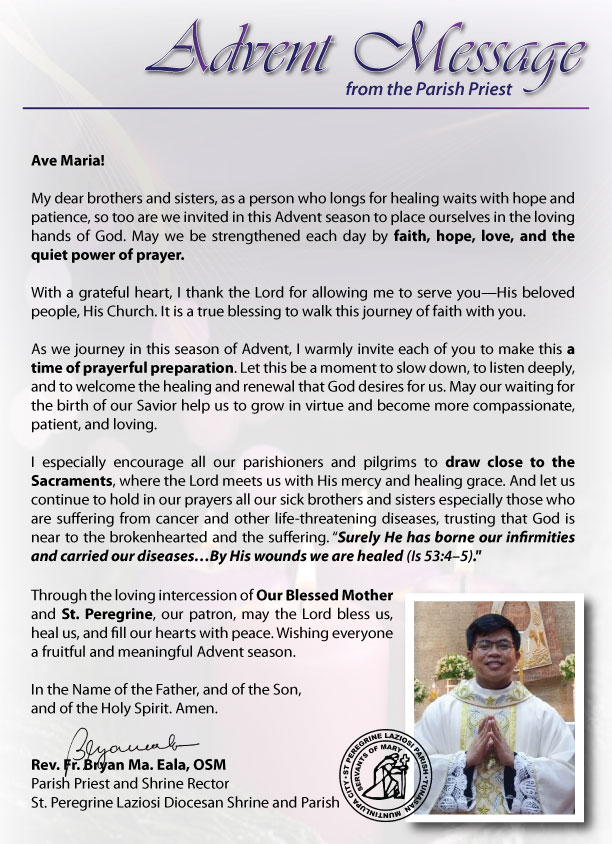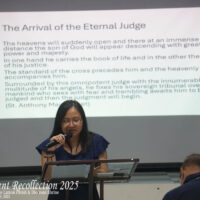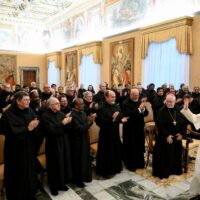(Vatican Radio) On Thursday, Pope Francis celebrated a solemn Mass for the Feast of the Presentation of the Lord, and also commemorated the 21st annual World Day for Consecrated Life.
In his homily for the Mass, the Holy Father called on consecrated women and men to “accompany Jesus as He goes forth to meet His people, to be in the midst of His people.”
Below, please find the full text of Pope Francis’ homily for the feast of the Presentation of the Lord:
Homily of His Holiness Pope Francis
Feast of the Presentation of the Lord
2 February 2017
When the parents of Jesus brought the Child in fulfilment of the prescriptions of the law, Simeon, “guided by the Spirit” (Lk 2:27), took the Child in his arms and broke out in a hymn of blessing and praise. “My eyes”, he said, “have seen your salvation, which you have prepared in the presence of all peoples, a light for revelation to the Gentiles, and for glory to your people Israel” (Lk 2:30-32). Simeon not only saw, but was privileged to hold in his arms the long-awaited hope, which filled him with exultation. His heart rejoiced because God had come to dwell among his people; he felt his presence in the flesh.
Today’s liturgy tells us that in that rite, the Lord, forty days after his birth, “outwardly was fulfilling the Law, but in reality he was coming to meet his believing people” (Roman Missal, 2 February, Introduction to the Entrance Procession). This encounter of God with his people brings joy and renews hope.
Simeon’s canticle is the hymn of the believer, who at the end of his days can exclaim: “It is true, hope in God never disappoints” (cf. Rm 5:5). God never deceives us. Simeon and Anna, in their old age, were capable of a new fruitfulness, and they testify to this in song. Life is worth living in hope, because the Lord keeps his promise. Jesus himself will later explain this promise in the synagogue of Nazareth: the sick, prisoners, those who are alone, the poor, the elderly and sinners, all are invited to take up this same hymn of hope. Jesus is with them, Jesus is with us (cf. Lk 4:18-19).
We have inherited this hymn of hope from our elders. They made us part of this process. In their faces, in their lives, in their daily sacrifice we were able to see how this praise was embodied. We are heirs to the dreams of our elders, heirs to the hope that did not disappoint our founding mothers and fathers, our older brothers and sisters. We are heirs to those who have gone before us and had the courage to dream. Like them, we too want to sing, “God does not deceive; hope in him does not disappoint”. God comes to meet his people. And we want to sing by taking up the prophecy of Joel and making it our own: “I will pour out my spirit on all flesh; your sons and your daughters shall prophesy, your old men shall dream dreams, and your young men shall see visions” (2:28).
We do well to take up the dreams of our elders, so that we can prophesy in our day and once more encounter what originally set our hearts afire. Dreams and prophecies together. The remembrance of how our elders, our fathers and mothers, dreamed, and the courage prophetically to carry on those dreams.
This attitude will make us fruitful. Most importantly, it will protect us from a temptation that can make our consecrated life barren: the temptation of survival. An evil that can gradually take root within us and within our communities. The mentality of survival makes us reactionaries, fearful, slowly and silently shutting ourselves up in our houses and in our own preconceived notions. It makes us look back, to the glory days – days that are past – and rather than rekindling the prophetic creativity born of our founders’ dreams, it looks for shortcuts in order to evade the challenges knocking on our doors today. A survival mentality robs our charisms of power, because it leads us to “domesticate” them, to make them “user-friendly”, robbing them of their original creative force. It makes us want to protect spaces, buildings and structures, rather than to encourage new initiatives. The temptation of survival makes us forget grace; it turns us into professionals of the sacred but not fathers and mothers, brothers and sisters of that hope to which we are called to bear prophetic witness. An environment of survival withers the hearts of our elderly, taking away their ability to dream. In this way, it cripples the prophecy that our young are called to proclaim and work to achieve. In a word, the temptation of survival turns what the Lord presents as an opportunity for mission into something dangerous, threatening, potentially disastrous. This attitude is not limited to the consecrated life, but we in particular are urged not to fall into it.
Let us go back to the Gospel passage and once more contemplate that scene. Surely, the song of Simeon and Anna was not the fruit of self-absorption or an analysis and review of their personal situation. It did not ring out because they were caught up in themselves and were worried that something bad might happen to them. Their song was born of hope, the hope that sustained them in their old age. That hope was rewarded when they encountered Jesus. When Mary let Simeon take the Son of the Promise into his arms, the old man began to sing of his dreams. Whenever she puts Jesus in the midst of his people, they encounter joy. For this alone will bring back our joy and hope, this alone will save us from living in a survival mentality. Only this will make our lives fruitful and keep our hearts alive: putting Jesus where he belongs, in the midst of his people.
All of us are aware of the multicultural transformation we are experiencing; no one doubts this. Hence, it is all the more important for consecrated men and women to be one with Jesus, in their lives and in the midst of these great changes. Our mission – in accordance with each particular charism – reminds us that we are called to be a leaven in this dough. Perhaps there are better brands of flour, but the Lord has called us to be leaven here and now, with the challenges we face. Not on the defensive or motivated by fear, but with our hands on the plough, helping the wheat to grow, even though it has frequently been sown among weeds. Putting Jesus in the midst of his people means having a contemplative heart, one capable of discerning how God is walking through the streets of our cities, our towns and our neighbourhoods. Putting Jesus in the midst of his people means taking up and carrying the crosses of our brothers and sisters. It means wanting to touch the wounds of Jesus in the wounds of a world in pain, which longs and cries out for healing.
To put ourselves with Jesus in the midst of his people! Not as religious “activists”, but as men and women who are constantly forgiven, men and women anointed in baptism and sent to share that anointing and the consolation of God with everyone.
To put ourselves with Jesus in the midst of his people. For this reason, “we sense the challenge of finding and sharing a ‘mystique’ of living together, of mingling and encounter, of embracing and supporting one another, of stepping into this flood tide which, while chaotic, can [with the Lord] become a genuine experience of fraternity, a caravan of solidarity, a sacred pilgrimage… If we were able to take this route, it would be so good, so soothing, so liberating and hope-filled! To go out of ourselves and to join others” (Evangelii Gaudium, 87) is not only good for us; it also turns our lives and hopes into a hymn of praise. But we will only be able to do this if we take up the dreams of our elders and turn them into prophecy.
Let us accompany Jesus as he goes forth to meet his people, to be in the midst of his people. Let us go forth, not with the complaining or anxiety of those who have forgotten how to prophesy because they failed to take up the dreams of their elders, but with serenity and songs of praise. Not with apprehension but with the patience of those who trust in the Spirit, the Lord of dreams and prophecy. In this way, let us share what is truly our own: the hymn that is born of hope.
Photo credits: http://media02.radiovaticana.va/photo/2017/02/02/AP3845547_Articolo.jpg
 Diocese of Parañaque
Diocese of Parañaque
















